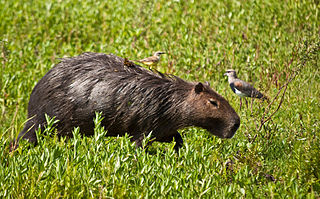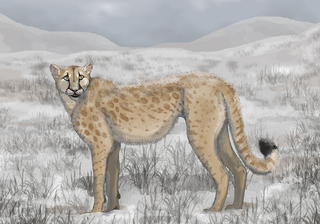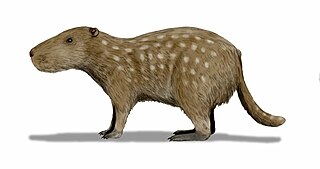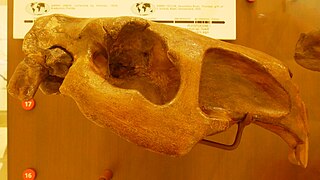
The capybara or greater capybara is the largest living rodent, native to South America. It is a member of the genus Hydrochoerus. The only other extant member is the lesser capybara. Its close relatives include guinea pigs and rock cavies, and it is more distantly related to the agouti, the chinchilla, and the nutria. The capybara inhabits savannas and dense forests, and lives near bodies of water. It is a highly social species and can be found in groups as large as 100 individuals, but usually live in groups of 10–20 individuals. The capybara is hunted for its meat and hide and also for grease from its thick fatty skin.

Caviidae, the cavy family, is composed of rodents native to South America and includes the domestic guinea pig, wild cavies, and the largest living rodent, the capybara. They are found across South America in open areas from moist savanna to thorn forests or scrub desert. This family of rodents has fewer members than most other rodent families, with 19 species in six genera in three subfamilies.

The genus Hydrochoerus contains two living and three extinct species of rodents from South America, the Caribbean island of Grenada, California and Panama. Capybaras are the largest living rodents in the world. The genus name is derived from the Greek ὕδωρ 'water' plus χοίρος 'pig'.

Miracinonyx is an extinct genus of felids belonging to the subfamily Felinae that was endemic to North America from the Pleistocene epoch and morphologically similar to the modern cheetah, although its apparent similar ecological niches have been considered questionable due to anatomical morphologies of the former that would have limited the ability to act as a specialized pursuit predator. The genus was originally known from fragments of skeletons, but nearly complete skeletons have been recovered from Natural Trap Cave in northern Wyoming.

The genus Phenacomys is a group of North American voles. The genus name comes from the Greek for "imposter mouse."

The Great American Biotic Interchange, also known as the Great American Interchange and the Great American Faunal Interchange, was an important late Cenozoic paleozoogeographic biotic interchange event in which land and freshwater fauna migrated from North America to South America via Central America and vice versa, as the volcanic Isthmus of Panama rose up from the sea floor, forming a land bridge between the previously separated continents. Although earlier dispersals had occurred, probably over water, the migration accelerated dramatically about 2.7 million years (Ma) ago during the Piacenzian age. It resulted in the joining of the Neotropic and Nearctic biogeographic realms definitively to form the Americas. The interchange is visible from observation of both biostratigraphy and nature (neontology). Its most dramatic effect is on the zoogeography of mammals, but it also gave an opportunity for reptiles, amphibians, arthropods, weak-flying or flightless birds, and even freshwater fish to migrate. Coastal and marine biota were affected in the opposite manner; the formation of the Central American Isthmus caused what has been termed the Great American Schism, with significant diversification and extinction occurring as a result of the isolation of the Caribbean from the Pacific.

Castoroides, or the giant beaver, is an extinct genus of enormous, bear-sized beavers that lived in North America during the Pleistocene. Two species are currently recognized, C. dilophidus in the Southeastern United States and C. ohioensis in most of North America. C. leiseyorum was previously described from the Irvingtonian age but is now regarded as an invalid name. All specimens previously described as C. leiseyorum are considered to belong to C. dilophidus.

Caviomorpha is the rodent parvorder that unites all New World hystricognaths. It is supported by both fossil and molecular evidence. The Caviomorpha was for a time considered to be a separate order outside the Rodentia, but is now accepted as a genuine part of the rodents. Caviomorphs include the extinct Heptaxodontidae, the extinct Josephoartigasia monesi and extant families of chinchilla rats, hutias, guinea pigs and the capybara, chinchillas and viscachas, tuco-tucos, agoutis, pacas, pacaranas, spiny rats, New World porcupines, coypu and octodonts.

The Dinomyidae are a family of South American hystricognath rodents: the dinomyids were once a very speciose group, but now contains only a single living species, the pacarana. Several of the extinct dinomyids were among the largest rodents known to date; these included the bison-sized Josephoartigasia monesi and the smaller Josephoartigasia magna. The dinomyids are thought to have occupied ecological niches associated with large grazing mammals due to their ability to compete with the native ungulates of South America. On the other side, they could feed on aquatic or swampy plants along the ancient rivers. These large forms disappeared after the formation of a connection to North America. The modern pacarana is only modest in size, considerably smaller than the capybara.

Neochoerus pinckneyi, commonly called Pinckney's capybara, was a North American species of capybara. While capybaras originated in South America, formation of the Isthmus of Panama three million years ago allowed some of them to migrate north as part of the Great American Interchange. Capybaras and porcupines are the only caviomorph rodents that reached temperate North America during this exchange. At 90–113 kilograms (198–249 lb), 40% larger than the living capybara, N. pinckneyi is one of the largest rodent species ever discovered, surpassed only by Josephoartigasia monesi, several species of Phoberomys, and possibly the Pleistocene giant beaver. Remains have been found in southern North America, from Arizona to Florida to South Carolina, and throughout Central America.

The genus Kerodon contains two species of South American rock cavies, related to capybaras and guinea pigs. They are found in semiarid regions of northeast Brazil known as the Caatinga. This area has a rocky terrain with large granite boulders that contain rifts and hollows where Kerodon species primarily live.

Hydrochoerinae is a subfamily of Caviidae, consisting of two living genera, Hydrochoerus, the capybaras, and Kerodon, the rock cavies. In addition, a number of extinct genera related to capybaras should also be placed in this subfamily. The taxonomy of Hydrochoerinae is confused because, until 2005, living capybaras and their extinct relatives were placed in their own family, Hydrochoeridae. Recent molecular phylogenetic studies recognize a close relationship between Hydrochoerus and Kerodon, supporting placement of both genera in a subfamily of Caviidae. Paleontological classifications have yet to incorporate this new taxonomy, and continue to use Hydrochoeridae for all capybaras, while using Hydrochoerinae for the living genus and its closest fossil relatives such as Neochoerus. The taxonomy of fossil hydrochoerines is also in a state of flux. In recent years, the diversity of fossil hydrochoerines has been substantially reduced. This is largely due to the recognition that capybara molar teeth show strong variation in shape over the life of an individual. In one instance, material once referred to four genera and seven species on the basis of differences in molar shape is now thought to represent differently aged individuals of a single species, Cardiatherium paranense.

Pleistocene rewilding is the advocacy of the reintroduction of extant Pleistocene megafauna, or the close ecological equivalents of extinct megafauna. It is an extension of the conservation practice of rewilding, which aims to restore functioning, self-sustaining ecosystems through practices that may include species reintroductions.

Josephoartigasia is an extinct genus of enormous dinomyid rodent from the Early Pliocene to Early Pleistocene of Uruguay. The only living member of Dinomyidae is the pacarana. Josephoartigasia is named after Uruguayan national hero José Artigas. It contains two species: J. magna, described in 1966 based on a left mandible, and J. monesi, described in 2008 based on a practically complete skull. Both are reported from the San José Member of the Raigón Formation by the Barrancas de San Gregorio along the shores of Kiyú beach.

The lesser capybara is a large semi-aquatic rodent found in South America that has vast similarities, yet subtle differences, with the common Capybara, the largest species of rodent in the world.
Hydrochoerus gaylordi is an extinct species of capybara that lived in Grenada during the Late Pliocene to Early Pleistocene. This species was found in 1991 by Ronald Singer and his colleagues based on a maxilla bearing 3 molars, but it was not named until 2000. It may be invalid and a synonym of the extant greater capybara.

Megistonyx is an extinct genus of ground sloth endemic to South America during the Late Pleistocene (Lujanian). It is known from one skeleton collected in the Andes of Venezuela, and is closely related to Ahytherium.

Neolicaphrium is an extinct genus of ungulate mammal belonging to the extinct order Litopterna. This animal lived from the Late Pliocene (Chapadmalalan) to the Late Pleistocene (Lujanian) in southern South America, being the last survivor of the family Proterotheriidae.

Hydrochoerus hesperotiganites is an extinct species of capybara that lived in San Diego County, California, during the Rancholabrean stage of the Pleistocene. It is currently the only known capybara of the genus Hydrochoerus found in North America. It was closely related to the modern Greater and Lesser Capybara.
















